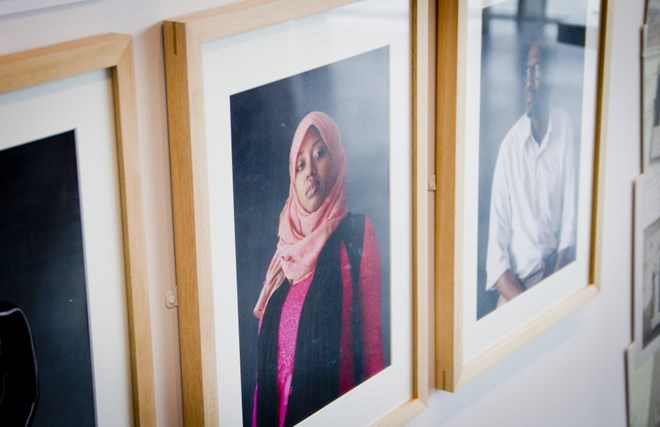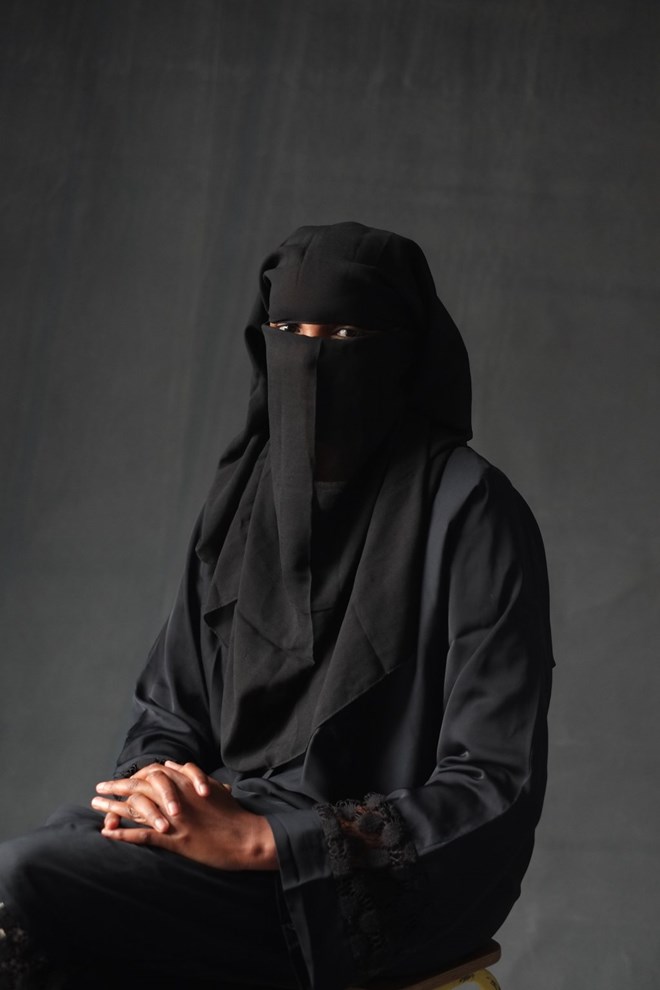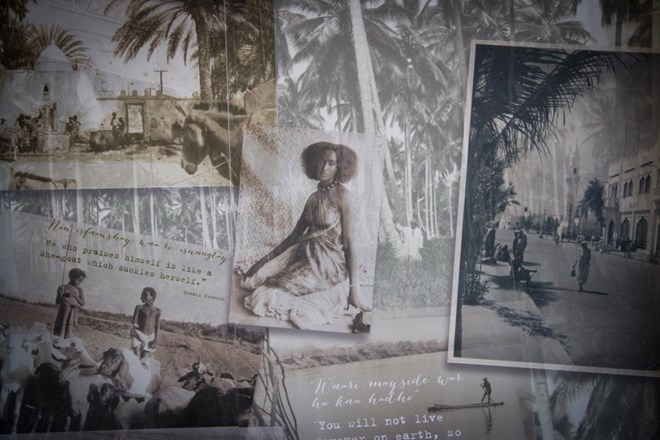InfoMigrants
Monday August 13, 2018
The United Kingdom is home to the largest Somali community in Europe, many of whom arrived in the 1990s or before. But the struggle for integration is ever present despite nearly 75 percent of the community possessing British citizenship. Emma Wallis looks into the reasons why.

Yasmin Olaad, pictured in the center | Eve Andreski, M Shed Bristol City Museums
Yasmin Olaad looks straight at
the camera and speaks confidently. She is wearing a pretty pink
patterned headscarf and a bright pink lacy long-sleeved dress. She is
part of an exhibition at Bristols' M Shed museum showcasing the stories
of young Somalis in the city of Bristol, home to the fastest growing
Somali community in the UK.
Today, Yasmin Olaad works for the UN and travels
the world. She counts herself as fortunate and can attest to lots of
positive experiences. Nevertheless, occasionally she has to contend with
prejudice.
She recounts the time she was
telling an acquaintance she was about to embark on a PhD. He looked at
her and said, “you know you need a degree and a masters degree for
that!” Perhaps accompanied by a withering stare, she shot back: “I have a
first class degree and a first class masters, so why are you assuming
that I don’t?” She goes on, “they expect you to be really poor and
uneducated, but overall my experience has been 80-90 percent positive.” Olaad thinks this is because Somalis are really adaptable and there is a lot of positivity in Somali culture.
But despite the positivity, the wider community has
sometimes struggled with certain aspects of integration in the UK. And
that struggle has been further complicated by the fact that most Somalis
are Muslim.Muna Abdi sits in a full Niqab.
She too is part of the Bristol exhibition that was on show until April
2018 and that will be digitized to go online soon. Abdi's hands rest
calmly in her lap and then via an audio link you hear her speak. Clear
Bristolian vowels roll warmly from her lips, perhaps not what many
viewing the exhibition would have expected from her strict Muslim dress,
and that’s the point.
“I’ve lived in Bristol 23
years,” she confides. “What don’t I love about Bristol?” she
rhetorically asks, going on to respond: “the lush accent, the lovely
attitudes of the people, the beautiful city; the fact that there is so
much variety; […] everyone is just from everywhere in Bristol. It is so
diverse and beautiful. I absolutely love Bristol.”
Breaking down those barriers and
challenging people’s expectations is what the exhibition at Bristol’s M
Shed museum was all about. The M Shed Museum wanted to get communities
talking by displaying the stories of Bristol's fastest growing Black and
Minority Ethnic (BME) community, the Somalis.
Until recently, those Somalis tended to come to
society’s attention, if at all, because of negative news stories
focusing on Female Genital Mutilation (FGM), Crime, Drugs, poverty and
the oppression of women. In short, if they were seen at all, they were
not fully functioning members of society and were oppressed or poor.

Millions of Somali refugees
The Somali diaspora is one of the largest refugee
populations in the world, with almost one million Somali refugees
globally according to the UNHCR, the UN Refugee Agency. As of 30 June
2018, 2.6 million Somali people were displaced internally (IDP) and
almost 1 million were forced to leave the country.
In the last three and a half
years, internal displacement trends have increased 125 percent,
according to the UNHCR’s fact sheet released in June 2018. Drought,
conflict and continuing insecurity are the main reasons for Somalis to
leave their homes, even today. Since the 1990s, war and unrest wrought
havoc on the country and caused Somalis to look for new homes.
Challenges in the UK
In the UK, most of the Somali
communities have been established since the 1990s and some decades, even
centuries before. Despite not being recent arrivals, educational
attainment has not always been as high as in some other migrant
communities - despite Olaad’s example. This is also true for those born in the UK.
Unemployment and poverty are
also factors which continue to dog many in the Somali British community.
In the last three years, three Islamist influenced attacks in the UK
and Belgium were perpetrated by young men with Somali origins which
shone a negative spotlight on the community.
According to official figures,
there are about 5,000 Somalis living in Bristol, but unofficial
estimates think it could be double that.
Despite the numbers, Somalis weren't particularly visible, or vocal, as a group,
until recently.The struggle for acceptance is common for the
Somali community in Bristol and across the UK. The two-way integration
that Bristol authorities are aiming for can occasionally be
misunderstood, explains Abdi Mohammed, a director of the Somali Media
Group, who also took part in the exhibition.
"Integration: What does that
mean to us? Is it in terms of culture? Is it in terms of assimilation
which is sometimes very difficult? For me it is, [asking the question]:
are we contributing?" He thinks there is a huge amount of contribution
from the Somali community, both socially and economically and that, he
concludes, is how integration should be measured.
The use of labels
In the UK, Somalis are often not seen as a group
apart but as part of the wider Black and Minority Ethnic (BME)
community. That is ignoring the complexity of identities within the
Somali community itself, thinks Sado Jirde. She's director of the Black
South West Network in Bristol which works for race equality. Sado is an
ethnic Somali who grew up in Kenya and then the UK.
"I guess naturally, when we tend to look at the
BME community we see them as a homogeneous group, but that is not the
case. They might be black but even in the context of Africa, culturally
[each country is] very different, and religiously they are very
different [too.] The Somalis, even within themselves have fundamental
issues, they have clans, they have other things, so I wouldn't even call
the Somalis one thing."
Most Somalis in the UK are Muslim. That wasn't
always the case, Finn White, the curator of the exhibition, explains.
They showed the group who were part of the exhibition photos that the
museum held of Somalians and Somalilanders from the past.
Many of the younger generation were surprised to
see that their forefathers and mothers did not always wear the Hijab and
were a lot less covered up than the dress they consider "traditionally
Somali" today. Today’s adherence to Islamic dress codes can also present
difficulties to integration for the host society because of the
negative connotations that have become associated with Muslims since
2001 and the so-called 'war on terror.'
This has made younger
Somalis even more determined to identify themselves first and foremost as
Muslims, thinks Sado Jirde. "The younger generation would actually
identify themselves as Muslim before they identify themselves as Somalis. If
you are Muslim your Islamic faith is very much what you see every day defined
in a very negative way. So it is political. How people identify, it is quite
complex, it's very much informed by how people feel in terms of their
surroundings."
And it's not just angry
young men who are shouting about their faith. Sado explains she took up wearing
the Hijab following the Brexit referendum in 2016.
"A lot of people
didn't even know I was a Muslim. But after the [Brexit] conversation, then
Trump came in and I thought I need to be counted and I want to be a Muslim
visibly.” Three days after the Brexit vote, she suffered what she calls a
'racist type attack' walking through the center of town. "I was actually
walking […] and I felt somebody hit me with a potato on the head. I've never felt
anything [like that] before."
The majority of the Somali community live in the eastern part of
Bristol, around Easton and Lawrence Hill. Like many in this area, their
integration is often compounded by the problems of poverty. Drug crime
is an ongoing problem.
A few years ago, a Somali drug gang was convicted of grooming and
gang-raping under-age girls, which further tarnished the community’s
reputation. Despite that, Mohammed Ali, a youth worker based in Easton
community center, says that it is the younger generation who are the
keys to integration.
"There are people [Somalis] who are working hard
to contribute to the city and also to reflect their presence in the
city. Somalis are now visible in politics. We have one councilor with a
Somali background. And there are others as well. You know there is a
generation which is coming up. That generation will contribute to the
city and they will improve integration."
Just around the corner from the community center
are a couple of streets lined with Somali businesses. Money exchange
facilities, internet points and convenience stores sit next to taxi
companies and restaurants. Many other members of minority ethnic
communities also use these facilities.

The director of the Somali media group, Abdi
Mohammed, has his office in the east of Bristol too. He thinks
contributing economically and socially is the key to integration and
avoids assimilation.
The exhibition “provided that opportunity to listen to stories and
[…] to actually talk to some real people," explains Finn White. Seeing
themselves and their stories celebrated on the wall has galvanized the
Somali community too.
White remembers Somali teenagers, who weren't in the exhibition,
lining up to take selfies in front of it and young Somali school
children rushing up to the exhibition to touch and gaze in awe at seeing
people like them reflected back at them from the walls of an
institution.
Sado Jirde, who came up with the proposal for the
exhibition, would agree. She thinks publicizing 'normal' people's
stories for everyone to read has helped break down barriers. It has given her hope for the future. Though
challenges exist, removing labels and getting to know each other is the
only way to move forward and build a positive future for integration,
Jirde says.